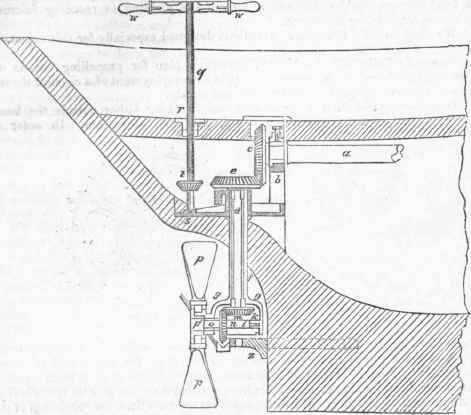Hunt's Steering And Propelling Apparatus
Description
This section is from the book "The Engineer's And Mechanic's Encyclopaedia", by Luke Hebert. Also available from Amazon: Engineer's And Mechanic's Encyclopaedia.
Hunt's Steering And Propelling Apparatus
The distinguishing feature of this apparatus consists in its combining the two operations of propelling and steering in one. The following description we quote from the inventor's specification:-
"a is a driving shaft, connected in the usual way with a steam engine or other first mover; b an upright bearer on which the shaft a works, c a bevelled cog-wheel, attached to the end of the driving shaft, d a hollow vertical shaft (made hollow for the purpose of receiving occasionally a supply of oil to lubricate its different bearing points) which passes down, right through the stern of the vessel close to the water line, and reaches outside to near the keel, where it rests in a projecting heel-piece, h, bolted firmly to the keel or kelson, carrying at top a second cog-wheel e, which takes into the first cog-wheel c, and at bottom a third cog-wheel m, which takes into a fourth n, which acts immediately on the propellers hereinafter mentioned;/is a case which encloses the vertical shaft d, and is connected with it at top and bottom by gun-metal bearings; g a trunk (formed by an enlargement at the bottom of the case /,) which encloses and protects the third and fourth cog-wheels m and n, and is made of brass or some other metal not readily oxidizable; i is a short horizontal shaft on which the fourth cog-wheel n is fixed, one end of which shaft rests in the bearing k, inside of the trunk g, and the other passes through the trunk g into a coupling box o; p p is a nave or boss at the end of the coupling box o, into which are fixed, at right angles the one to the other, the four blades or propellers p, by which progressive motion is given to the vessel.
So much of the apparatus as I have hereinbefore described, is employed solely for propelling purposes, and its mode of operation is as follows: - The driving shaft on being set in motion by the steam engine or other first mover turns the first cog-wheel c, which turns the second cog-wheel e, which (through the medium of the shaft d,) turns the third cog-wheel m, which turns the fourth or last cog-wheel n, which turns the shaft i, which (through the medium of the coupling box o, and boss p p,) causes the blades or propellers, p, to rotate and thereby propel the vessel. The steering part of the apparatus I shall now proceed to describe. w w are the arms of a steering wheel fixed on the top of a vertical shaft g, which passes through the vessel's deck, turning freely on its centre in the bearing r, and resting at bottom in a socket s. On this shaft a bevelled cog-wheel t is fixed, the cogs of which work into a corresponding set of cogs at the end of a horizontal screw shaft v, which takes into a quadrant x, (separately shown in the adjoining cut, but omitted for sake of clearness in the preceding figure,) which is attached to the top of the case f, which encloses the vertical shaft e.
It follows from the series of combinations last described, that according as the steersman turns the wheel to the one side or the other he must turn to one side or the other the quadrant x, which is attached to the top of the case/, which governs (through the medium of the shafts d and i, and the gear work in connexion with them) the position of the propellers, p p, and so cause the propellers always to act in a line exactly coincident with that desired to be given to the vessel."

Continue to:


